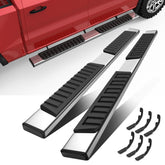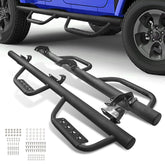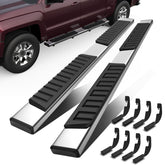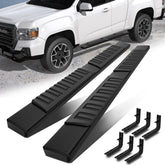How Much Weight Running Boards Can Hold?
When buying running boards, the weight capacity of many running boards is not always listed, which is confusing for customers who need to consider the load rating. For this reason, our experts have compiled this guide to introduce the weight capacity of running boards to customers and help you make a better choice.
What factors influence running boards' weight capacity?
Material Impact
The material used in running boards determines 80% of its load-bearing capacity. Common materials used to make running boards include aluminum, steel, and plastic. Different materials have different properties, and the load-bearing capacity of the final running boards will vary greatly.
- Aluminum is not only light, but also strong, and can support 300 to 500 pounds.
- Steel has a higher strength than aluminum. When used in heavy pickup trucks, it can withstand 600 pounds or more. The disadvantage is that it is heavier and inconvenient for one person to install.
- High-density plastic has the lowest load-bearing capacity, usually between 200 and 400 pounds. It may have a market because of its lower cost.
The material affects the strength and load-bearing capacity of the running boards but also their corrosion resistance and weather resistance, which are directly related to the service life of the running boards. High-quality materials can improve the load-bearing capacity and ensure safety during use. Manufacturers will comprehensively consider factors such as material cost and the scenarios in which users use running boards to choose which material to use, which ultimately determines the ability to effectively support weight.

Design Influence
As we all know, “triangles are structurally stable.” The structure of a running board also plays an important role in its weight capacity. A well-designed structure can evenly distribute weight across the entire board, allowing it to bear weight stably and avoid damage caused by concentrated force. Support brackets, reinforcements, and wider surfaces can enhance stability and load-bearing capacity. For example:
- A running board with a double support bracket design can withstand loads of up to 800 pounds.
- The shape of the running board (whether it is flat or contoured) affects the load-bearing capacity. The larger the force area you have, the less pressure you will receive, so a wider platform can bear more weight and help you enter and exit the vehicle safely. Therefore, a flat design can withstand 200 to 300 pounds more weight than a contoured design due to the wider contact area.
Sometimes designers sacrifice the load-bearing function of a running board for aesthetics. They balance style with the integrity of the structural function to ultimately ensure that the footboard can safely withstand the expected load.
Brand Differences
In addition to materials and design, the brand also affects the weight-bearing capacity of running boards. Before a company decides to produce a product, they will do sufficient market research, and make it according to the real needs of the market and the product positioning. Therefore, different brands will set different weight-bearing capacity standards when they design their products. During the production process, it is also affected by their engineering practices and quality control measures. Well-known brands have more financial strength and can provide running boards with weight capacities ranging from 400 to 800 pounds. They can also conduct more rigorous testing for their products so that consumers can have confidence in their weight-bearing ratings. Some unknown brands do not invest as much money in research and development, resulting in inconsistent quality of running boards and lower weight-bearing capacities, usually between 200 and 400 pounds. Choosing a trusted brand can significantly affect the safety and reliability of the board under load.
Different Running Boards' Weight Capacity
Traditional Running Boards
Traditional running boards are flat steps primarily used on taller SUVs and pickup trucks, such as the Ford F-150, Toyota Tacoma, and Chevrolet Silverado. They not only help you get in and out of your pickup truck or SUV easily, but their wide design complements the tall chassis of these models.
They are made of metal materials such as aluminum or steel and can support considerable weight. Most traditional running boards have a weight capacity of between 300 and 600 pounds. Some running boards have a non-slip surface for added safety. This feature is useful in wet or muddy conditions.
Traditional running boards have a simple design and are bolted directly to the vehicle frame, securely attached, and ready to use. This mounting method minimizes the risk of bending or breaking due to heavy pressure. These running boards are suitable for daily use, especially for family travel and carrying heavy items. They provide a stable step, making it easy for children and elderly people to get in and out of the vehicle, and are also suitable for carrying equipment and tools.

Nerf Bars
Nerf bars are a popular alternative to traditional running boards. They are round or oval in shape, made primarily of stainless steel or aluminum, and have a weight capacity between 300 and 500 pounds. They are designed to look stylish while still providing functional support. Nerf bars are used on off-road and sporty SUVs, such as the Jeep Wrangler and Toyota 4Runner. Their streamlined design matches the sporty feel of these vehicles. Nerf bars are suitable for off-road driving and light adventure activities. One of the main advantages of the bars is their versatility. They provide additional grip and stability when driving on rough terrain, helping drivers get on and off the vehicle safely in muddy or rough terrain. The bars also come with a textured step surface to help prevent slips. This is especially useful for people wearing boots or those whose steps are wet.
Installation is similar to traditional running boards, with the bars attached to the frame of the vehicle using mounting brackets. Nerf bards emphasize style and grip rather than maximum weight. It is a perfect choice for truck enthusiasts because it combines fashion and functionality.

Power Running Boards
Power running boards are the most advanced type of running boards. They feature electric functions, eliminating the need to manually deploy the board. Once you install it, it automatically extends when the door is opened and retracts when the door is closed, making it particularly useful for families or individuals with limited mobility. Electric running boards are usually made of durable materials such as aluminum or high-strength steel, and the weight capacity of electric running boards is usually between 300 and 600 pounds. Electric running boards are suitable for a variety of high-chassis models, including luxury SUVs and pickup trucks, such as the Ford Explorer, Toyota Land Cruiser, and Mercedes-Benz GL Series. They are often paired with high-end models to enhance the sense of luxury and convenience.

Four main factors affect the weight capacity of electric running boards:
- The main goal of electric running boards is to provide convenience and aesthetics, and weight capacity is not the primary consideration in their design.
- Electric running boards rely on electric motors and mechanical structures to achieve extension and retraction. These components must be lightweight for easy movement, so they are not as sturdy as traditional running boards and Nerf Bars in terms of material and structural selection.
- The design of electric running boards requires movement when opening and closing, which increases wear and stress on the components. Therefore, the load-bearing capacity is designed to be relatively conservative to ensure safety and durability.
- Although many electric running boards use aluminum or high-strength steel, to accommodate the electric mechanism, some compromises are made in thickness and strength, which affects the load-bearing capacity.
Common running boards Brands and Models
Running boards enhance the accessibility and style of pickup trucks and SUVs. Here are some well-known running board brands and their famous models.
MOSTPLUS black aluminum running boards
The Black Aluminum Running Boards from MOSTPLUS are both lightweight and durable, offering an innovative solution for vehicle modification. Made from high-grade aluminum, these running boards are resistant to wear and tear. The sleek black finish complements any vehicle color and enhances its visual appeal. Each running board can support up to 220 pounds, ensuring safe entry and exit for all users. The running boards feature a non-slip surface for increased entry and exit safety. Installation is also simple, allowing users to quickly upgrade their vehicles. MOSTPLUS emphasizes affordability without compromising on quality, making their running boards a popular choice for many.

Tyger Auto star armor nerf bars
Tyger Auto Star Armor guardrails are easy to use and keep your vehicle safe. They feature a sleek stainless steel construction that resists rust and corrosion. The textured surface provides a secure grip, giving you plenty of friction even in wet conditions. Each guardrail can support up to 300 pounds. Installation is simple, with no drilling required, making it suitable for most users. These guardrails enhance the overall aesthetic of your vehicle, blending functionality with style. Tyger Auto products meet stringent safety standards, giving users peace of mind.

AMP Research electric running boards
AMP Research's groundbreaking power running boards automatically deploy when the vehicle door is opened, providing unmatched convenience. They are made of heavy-duty aluminum and can support up to 600 pounds. When the door is closed, the running boards retract, ensuring a clean look. This design minimizes drag and improves fuel efficiency. These running boards are perfect for owners who are looking for a modern look with a functional edge.

Bestop running boards
Bestop is a trusted name in the automotive aftermarket. Their running boards are designed to withstand harsh conditions and are durable and easy to use. Made from sturdy powder-coated steel, these running boards can withstand up to 400 pounds. The non-slip surface ensures a firm stand even on uneven terrain. Combining practicality with a stylish look, these running boards are a great addition to your truck. With a focus on performance and reliability, Bestop is the first choice for outdoor enthusiasts.

How do you choose running boards based on their weight capacity?
Here are our experts’ picks:
Material
If you are a daily driver or have a family, choose aluminum running boards. Although it is more expensive than plastic running boards, it is a good choice considering its durability and 300 to 500 pounds of load capacity. If you often go off-road and need to carry heavy equipment or equipment, steel running boards can withstand more weight. Finally, assuming you are on a limited budget and do not use your truck frequently, plastic running boards are a cost-effective solution.
Design
Flat steps provide a larger stepping surface area, distributing weight evenly. This design is ideal for larger people or those with limited mobility, ensuring safe entry and exit from the vehicle. If the steps are too narrow, the weight capacity may be reduced, posing a risk to heavier users. Also, consider the tread on the step. Textured surfaces enhance grip and improve safety. This feature is beneficial for people who live in areas that experience frequent rain or snow, where the risk of slipping is higher.
Conclusion
That's all for this article. Hopefully, our guide will help you. If you have someone over 300 pounds at home, don't hesitate to choose a footboard with a better load capacity. At MOSTPLUS, we generally offer 220 to 300 pounds of Running boards to meet your daily needs
Featured Products
- $198.99
- $198.99
- Unit price
- / per
- $198.99
- $198.99
- Unit price
- / per
- $203.99
$203.39- $203.99
- Unit price
- / per
- $198.99
- $198.99
- Unit price
- / per
















